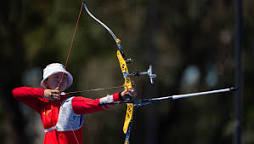The compound bow is a technological marvel that was invented very recently in 1966, in comparison to the fact that human has been bow hunting for tens of thousands of years.

You don’t really need to know about the science of compound bows but if you go to an archery, you’ll see archers using this bow.
Elements of a Bow: The Basics
Here are some basic terms when people talk about bows which parts refer to both recurve bows and compound bows.
The Riser is the handle of the bow that archers hold when prepare to shoot. Risers get complicated, but basically it features the arrow rest, which is where one place arrows before drawing. Recurve bows usually feature an elevated rest which is simple just a platform that the arrow sits on, and compound bows usually feature a containment rest. One of the most popular forms of containment rests is known as a “whisker biscuit.”
The Limbs are attached to the riser to form the actual bow, in which the top limb attached to the bottom limb via the bow string. If you ever hear the term “takedown bow”, this is where you can detach the old limbs of recurve bows, and replace them with newer, heavier limbs. Takedown bows are ide for beginners, because it allows players to replace new limbs on the bow as you develop strength and accuracy of shooting.
The Bow String connects the top limb to the bottom limb.
The Nock Point is the spot on the bowstring where archers put the end of the arrow which needs to adjust to stay in the same place, so that archers can aim and shoot consistently.
The Bow Sight like the scope on a rifles when being adjust properly, the sight allows archers to aim correctly at target. Many bows manufactured with sights, but many archers prefer an upgrade in which sights are attached/ detach to the riser whenever they want.
If that all seems like a bit much, don’t worry as practice will allow you to understand the details of those terms in no time.




